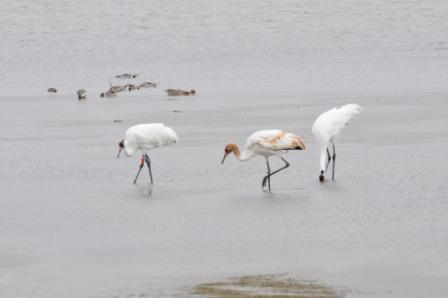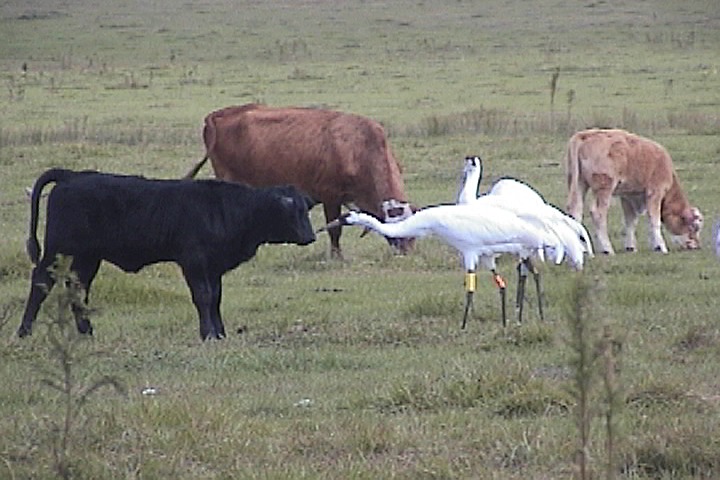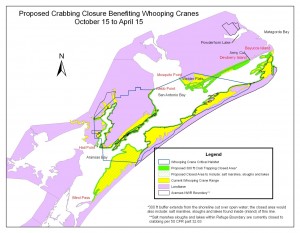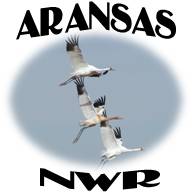Author Archive
Whooping Crane Update at Aransas NWR
December 18, 2011Most of the estimated 300 whooping cranes of the Aransas-Wood Buffalo population have now arrived on the Aransas National Wildlife Refuge on the Texas coast. The whoopers began arriving on the Texas coastal bend and Aransas National Wildlife Refuge wintering grounds in late October according to Dan Alonso, Refuge Manager. Regrettably the refuge habitat is suffering from the long drought that affects most of the state of Texas. “Habitat conditions appear to be somewhat challenging for whooping cranes this year, specifically with regard to drought and salinity aspects” advises refuge manager Alonso.
Salinity levels in the San Antonia Bay are currently 35.3 parts per thousand, resulting in many cranes frequently using inland freshwater sources according to refuge officials. “To date, Aransas National Wildlife Refuge has received 14 inches of precipitation, which is approximately 23 inches below the annual average” according to Alonso. In addition, harmful algae blooms, known as red tide, have occurred along the Texas coast. Red tide toxins can accumulate in fish, oysters and clams in the bays, possibly causing illness and/or death to cranes and other wildlife consuming toxic seafood. “Fortunately, there are no known reports of cranes dying from the red tide in past outbreaks but biologists continue to keep a
vigilant watch. Fortunately cooler temperatures have helped reduce red tide blooms”, refuge officials say.
Aransas biologists made their initial plane flight of the season on December 8 to check out the first whooping crane mortality discovered on Aransas according to a refuge report. One juvenile crane was found dead from unknown causes. The carcass has been sent to the National Wildlife Health Center in Madison, WI for disease testing.
Aransas officials say the goal of the first flight was also to assess the general distribution and condition of the whooping crane population. During the flight, biologists observed a significant number of cranes in the uplands, as opposed to marshlands where they are typically found. Field observations have resulted in biologists finding evidence of wolfberry and blue crab remains in crane scat. It appears that cranes are utilizing some resources within the marsh. A second flight to estimate the crane population will be scheduled for January 2011 according to refuge personnel.
Recognizing the potential problems associated with the extreme drought conditions along the entire Texas coast, Aransas officials spent the summer months planning for the return of the whoopers. This included initiating work to maximize freshwater output from existing wells located throughout the refuge. And the refuge has had some valuable assistance from the private sector.
The Friends of Aransas and Matagorda Island National Wildlife Refuge, a non-profit organization of volunteers are dedicated to supporting the refuge in its goal of enhancing habitat and wildlife. They have been instrumental in raising funds for converting windmills to solar pump energy. This conversion is intended to provide a more reliable fresh water supply for wildlife. Refuge personnel are also planning to prescribe burn over 9,700 acres to provide additional food resources for cranes. The refuge recently conducted its first burn of the season, consisting of 654 acres of whooping crane habitat. Refuge officials reported that the cranes made immediate use of the prescribe burned areas.
The Whooping Crane Conservation Association believes that Aransas officials are doing everything within their capabilities to compensate for the “challenging” habitat conditions on the refuge. Mother Nature has dealt Aransas Refuge and most of the state of Texas a serious blow with the long term drought. After a successful nesting season, with approximately 37 chicks fledging from a record of 75 nests in August 2011, biologists anticipate that the flock size could reach record levels this winter, possibly 300. The large whooper population will now face degraded habitat conditions and hopefully they will overcome the taxing situation.
Whooping Cranes Need YOUR Help!
December 18, 2011********************** MERRY CHRISTMAS and HAPPY NEW YEAR **********************
******************** from Whooping Crane Conservation Association *******************
The tiny bird in this photo is a week old whooping crane chick. Its parents will take excellent care of it in good habitat. But we are losing whooping crane habitat every day due to human development projects and reduced fresh water inflows to coastal estuaries. The Whooping Crane Conservation Association is acquiring whooper habitat. YOU CAN HELP! Please join the us and/or donate. Or give a special Christmas gift membership to a friend or family member. We will email you a gift certificate if you request one. For more information go to: https://whoopingcrane.com/membership/
Group Can Keep Fighting for Whooping Crane
December 9, 2011
Thursday, December 08, 2011Last Update: 3:40 PM PT
Group Can Keep Fighting for Whooping Crane
CORPUS CHRISTI, Texas
(CN) – A federal judge refused to rule on claims that Texas is threatening the existence of whooping cranes by allowing diversion of the birds’ freshwater source. In a March 2010 federal complaint, The Aransas Project (TAP) claimed that mismanagement in the Texas Commission on Environmental Quality and the South Texas Watermaster has brought the whooping crane to the brink of extinction, with 23 birds dying in the harsh 2008-09 winter.
By the end of the season, the Guadalupe Basin crane population had allegedly declined to 247. TAP links the loss of birds in the basin to the diversion of freshwater from the Guadalupe and San Antonio Rivers.
Both sides, as well as intervening defendant Guadalupe-Blanco River Authority, moved for summary judgment, but Senior U.S. District Judge Janis Graham Jack roundly rejected the motions Monday.
Though Jack refused to grant TAP’s motion for partial summary judgment on standing, she also held that the environmentalists’ complaint survived its adversaries’ challenges. Jack devoted a section of her order to determining whether the commission could be held liable for water-diversion activity conducted by third parties. “Plaintiff has alleged that the TCEQ defendants are responsible for water permitting and water diversions from the waterways at issue, and the increased diversions have left less water for the cranes, resulting in a taking,” Jack wrote, abbreviating the commission defendant’s name. “This type of causation is sufficient for an ESA suit challenging governmental regulation,” she concluded.
Regulatory agencies like the TCEQ can be held responsible for harming an endangered species through its regulations, according to the 45-page order. “The court recognizes that ‘a governmental third party pursuant to whose
authority an actor directly exacts a taking of an endangered species may be deemed to have violated the provisions of the ESA,’ specifically the ‘taking’ provision in ESA Section 9,” Jack wrote.”The court concludes that plaintiff provides enough evidence of a ‘taking’ of whooping cranes, both in terms of deaths and non-fatal harm, such as malnourishment, to survive a motion for summary judgment,” she added.
The judge concluded by disagreeing that the U.S. Supreme Court’s holding in Burford v. Sun Oil required her to dismiss. That 1943 decision blocked a challenge to oil drilling that the Texas Railroad Commission had approved.
Whoopers Reach Aransas in Large Numbers
November 23, 2011By: Chester McConnell, Whooping Crane Conservation Association
Whooping cranes are currently (11/23/2011) continuing to migrate from their nesting habitat in Canada to their winter habitat in the United States. Martha C. Tacha, U.S. Fish and Wildlife Service, Grand Island, NE is responsible compiling records of whooping crane sightings along the migration route. Tacha reports, “There are a still a few whooping cranes in the flyway. A single adult-plumaged bird was spotted at Quivira NWR and another at Salt Plains NWR. Only 43 whoopers have been confirmed north of Kansas since 11/9/2011. Interestingly, two additional single-parent families were detected and photographed. That makes three families with only one parent observed and photographed in the flyway this migration, which is both uncommon and troubling. Unfortunately, one of the GPS-marked juveniles was found dead west
central Kansas and cause of death is unknown at this time.”
Dan Alonso, Refuge Manager, Aransas National Wildlife Refuge estimated 80 percent (240) of the whoopers have now reached the refuge along the Texas coast. Eighteen of the 20 whoopers with GPS monitors attached have also reached the refuge. An aerial census is planned for next week to get a more definite count.
During their 2,400 mile southward migration, the cranes take their time, stopping periodically to feed in agricultural fields and wetlands. The southward migration will soon be completed and the whoopers will settled down for the winter on Aransas National Wildlife Refuge. Then when the spring season arrives, the birds will migrate back to their nesting habitat in Canada. Whooping cranes have followed this schedule for thousands of years.
The whooping crane’s natural habitats are essential to their survival. Until about the 1400’s, whooping cranes ranged across much of central North America, from as far north as Canada’s Northwest Territories to the southern coast of Texas. Though never believed to be abundant, their numbers were thought to be around 1,500 in the mid-1800. As European’s immigrated to North America in large numbers, their settlement and developments destroyed much of the whoopers nesting and winter habitats. Unregulated hunting also contributed to the whooper population decline. By the 1940s the whooping crane population had dropped to an all-time low of 15 birds. Aided by
protection and habitat management the original wild migratory flock has slowly recovered and now numbers approximately 300.
Currently, however, family units and small groups of juvenile whoopers continue their leisurely southward journey. They are headed to Aransas National Wildlife Refuge. The wintering habitat of the last remaining wild migratory flock of whooping cranes in the world is located in on Aransas Refuge on the central coast of Texas, USA.
Aransas was originally established by President Franklin Roosevelt in 1937 as a “refuge and breeding ground for migratory birds and other wildlife… and to conserve fish or wildlife which are listed as endangered or threatened species…”
The Aransas Refuge complex is comprised of over 115,000 acres including the Blackjack Peninsula (Aransas proper), Matagorda Island, and the Myrtle Foester Whitmire, Tatton, and Lamar units. These areas provide essential wintering habitat for the endangered whooping cranes in addition to vital resting, feeding, wintering, and nesting grounds for a wide assortment of migratory birds and native Texas wildlife.
The nesting habitat of the last remaining wild migratory flock of whooping cranes is located in Wood Buffalo National Park, Canada. Approximately 11 million acres (17,300 sq. mi.) in size, Wood Buffalo National Park is Canada’s largest national park and one of the largest parks in the world. The park was established in 1922 to protect the
free-roaming bison herds of the area. Now the park also focuses on supporting and protecting many unique natural and cultural resources, from diverse ecosystems and rare species like whooping cranes to the traditional activities of Aboriginal residents. During the 2011 nesting season wildlife biologist recorded 75 whooping crane nests on Wood Buffalo. Approximately 37 chicks fledged from the record 75 nests in August 2011. Due to this successful nesting season, the flock size may reach record levels of around 300 this fall.
Whooping crane pokes calf on nose
November 21, 2011**** Photo by Marty Folk ****
Whooping cranes, like all wild creatures, must defend themselves occasionally. The photo shows a whooper poking a calf on its nose to make it back off. During night time, whooping cranes try to roost in a shallow river or lake to help protect themselves from predators like coyotes and bob cats. During day time they can hold off some predators with their sharp beak. Or they can make high jumps or fly.
Whooping Crane Conservation Association www.whoopingcrane.com
277 Whoopers Spotted Migrating to Aransas NWR
November 17, 2011By Chester McConnell, Whooping Crane Conservation Association
Wildlife conservationist reported sighting whooping cranes at 61 locations stretching from North Dakota to Texas during the past week. Martha Tacha, U.S. Fish and Wildlife Service, Grand Island, Nebraska advised that, “As you might expect, many sightings have been confirmed since my last report. Although it would seem from the confirmed sightings that the migration has drifted southward, location information from the radio-tagged whoopers shows that there were still whooping cranes in North Dakota as recently as yesterday, 11/15.”
Tacha’s report shows a total of 277 whooping cranes were spotted, including 26 on Aransas National Wildlife Refuge in Texas. Two hundred and fifty-one were adults and 32 were juveniles. The 26 whoopers on Aransas Refuge were not identified by age. The total whooper population still migrating towards Aransas NWR is expected to number 300. This would be a record number that has grown from a low of 15 birds in the 1950s.
Twenty-one whoopers have active Global Positioning System (GPS) receivers attached to their bodies. The GPS is a satellite-based navigation system made up of a network of 24 satellites placed into orbit by the U.S. Department of Defense. The GPS receivers provide a means to track the movements of whooping cranes. Twelve of the 21 whooping cranes with active GPS receivers have reached the south Texas coast, with many confirmed sightings on and off Aransas National Wildlife Refuge (26 whoopers are occupying the Blackjack Peninsula on Aransas Refuge as of 11-15-2011). With daily high temps forecast below freezing as far south as Pierre, SD, perhaps the cranes will move south to find open water.
Whooping Cranes Quicken Flight to Aransas Winter Home
November 15, 2011By Chester McConnell, Whooping Crane Conservation Association
Whooping crane numbers are increasing rapidly on Aransas National Wildlife Refuge each day. While no official census will be made until later this month, refuge official report seeing growing numbers of the endangered birds. Dan Alonso, Refuge Manager told the Whooping Crane Conservation Association that “26 whooping cranes had been observed on the refuge along Shore Road”. More whoopers are likely on the refuge in areas where they are more difficult to spot.
Manager Alonso also advised that, “8 of the 20 radio marked whooping cranes have arrived on the refuge according to the U.S. Geological Survey monitoring team.” Radio equipment was placed on 20 whoopers to track their migration path from their nesting grounds on Wood Buffalo National Park, Canada to their winter habitat on Aransas Refuge, Texas. Biologists in Canada and the United States have studied whooping cranes for many years but still do not know all the bird’s secrets. Due to increasing developments along the cranes migration route, biologists and development interests need to know more about whooping crane movements to help protect the birds.
“Aransas Refuge is still in the midst of a severe drought” according to Refuge Manager Alonso. “The refuge and entire state of Texas is in serious need of rain”, he said. Weather reports are predicting rain for parts of Texas within the next few days and hopefully Aransas will get a good soaking.
Alonso explained that, “a second growing problem is the red tide in waters off shore of the refuge.” He stated that while, “red tide is always an issue, the current red tide is one of the worst ever recorded. The situation is monitored regularly by Texas Parks and Wildlife Department biologists.” He warned that “whooping cranes can die or become sickened by eating red tide infected mollusk.” He does not know if red tide has ever killed a whooping crane because dead cranes are often eaten by predators.
The last seriously bad red tide, similar to the current situation, was during 1995, according to manager Alonso.
We asked manager Alonso about the effect of crab trapping in the vicinity of Aransas Refuge. He explained that the U.S. Fish and Wildlife Service had searched for traps near Aransas refuge and had located none within 300 feet of the refuge shore. He reiterated that the reason for apparent absence of traps is that the waters near the refuge are too shallow for crabbing.
Whooping Crane Conservation Association Urges Crabbing Closure
November 8, 2011Whooping Crane Conservation Association president Lorne Scott sent letter to Texas Parks and Wildlife Department Executive Director Carter Smith requesting measures to help ensure adequate food source for whooping cranes. President Scott advises,”The Whooping Crane Conservation Association (WCCA) has been working to help whooping cranes for over 60 years. Since blue crabs are the main food source for wintering whooping cranes at Aransas, we are concerned with the long-term decline of blue crabs Gulf-wide, including the Texas coast. Specifically, we urge your Department to institute a seasonal closure on blue crab harvest in areas used by wintering whooping cranes.”
In 2009, personnel of Texas Parks and Wildlife Department (TPWD -Fisheries and Regulatory divisions) and Aransas National Wildlife Refuge (NWR) met several times and developed a proposal to expand the crab closure zone to all marshes currently being used by wintering whooping cranes. Also proposed was a closure 300 feet out from the marshes in the shallow parts of the bays where whooping cranes may forage. With crabbing currently prohibited on Aransas and Matagorda Island NWRs, the proposal would affect marshes on San Jose Island, Welder Flats and Lamar as well as bay edges throughout the crane area. This proposal would increase availability of blue crabs for wintering whooping cranes, reduce disturbance to the cranes, and would reduce the problem of traps being abandoned in the shallow marshes. The proposed closure would be seasonal in nature only for when the cranes are on the Texas Coast from October 15th through April 15th.
Your Department wanted to collect additional information on exactly how many licensed crab fisherman would be impacted, but this was never completed. TPWD personnel subsequently decided not to present this matter to your Commission, and the proposal was dropped.
The WCCA requests that TPWD re-consider this matter and bring it before the Commission. The closure would impact only a handful of commercial crabbers; it would reduce the problem of crab traps being placed in the shallow marshes and later abandoned when tides become too low to check traps; and it would signal the Department’s concern about the blue crab resource and the endangered whooping crane. In 2009, the Aransas NWR began to enforce a closure of the crab fishery on Matagorda Island. A similar move by TPWD for the crane areas including San Jose Island, Welder Flats and Lamar would benefit whooping cranes by increasing their food supply. It makes little sense to be trapping crabs during the whooping crane season (October 15 to April 15) since low tides during the winter make most of the marshes and bay shorelines inaccessible with fisherman unable to access traps. A seasonal closure would also reduce disturbance to whooping cranes, an issue of increasing concern as more and more people are able to access even the shallowest of marshes with kayaks and airboats.
A map of the seasonal proposed closure as discussed in 2009 is attached. We urge your Department to bring this matter to your commission for passage.
Whooping Cranes Spotted Along Migratory Route
November 5, 2011By: Chester McConnell, Whooping Crane Conservation Association
The fall migration of whooping cranes is at its peak according to the Whooping
Crane Conservation Association. Of the approximate 300 whooping cranes in the
total original wild flock, 128 have been positively spotted from North Dakota
to Texas. The whoopers have followed this migratory path for thousands of
years. Trained, professional wildlife personnel from federal and state agencies
and private conservation groups monitor the migration route to keep check on
the cranes.
Martha C. Tacha, U.S. Fish and Wildlife Service, Grand Island,
Nebraska advises that, there is “Lots of activity in the flyway
since the last update a week ago.” Tacha stated, “I’m sure the weather
front that moved through the Flyway recently will move the
cranes some more! The cranes are still strung from North Dakota to Aransas,
Texas but there are currently more cranes in Kansas and Oklahoma than last
week.”
Ms. Tacha informed the Whooping Crane Conservation Association
of one disturbing observation. She advised that at least two
whooping crane families have lost a parent. According to
Tacha, “The loss of breeding adults from 2 pairs is unfortunate; particularly
going into what may be a difficult winter at Aransas.”
A reassuring observation was also made by the trained spotters.
They detected the apparent presence of at least 5 whooping
crane families with twins. At first there was some doubt about the count
because it was unexpected. Yet 5 twin pairs were detected and there is little
chance the same cranes could have been counted twice due to the distance
between the observations. The Whooping Crane Conservation Association will
continue to monitor the recent discoveries and provide more details as we learn
about them.





